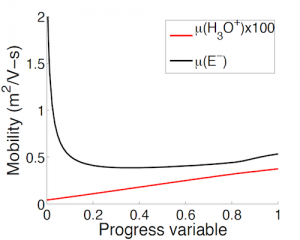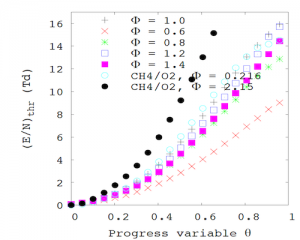It is well known that electric fields may influence flame behavior and combustion properties by acting upon the charged species produced naturally in flames. Among the observed effects are improvement of stabilization characteristics and reduction of pollutant emissions. However, the details of the physical processes are not well understood hindering our ability to enhance combustion using electric fields.
Numerical modeling is a valuable tool for the development of this area of research. The comprehensive modeling of the interaction of the electric field with flames is a very challenging subject, requiring a detailed knowledge of gas-discharge physics, hydrodynamics, transport phenomenon, and chemical kinetics. Research in our group explores all of those topics.
Our main goal is the development of chemistry and transport models capable of calculating spatial charged species profiles in flames under applied voltages.
- Develop models to characterize the ion and electron distribution in flames and the interaction of charged species with electric fields.
- Establish numerical tools for predicting the flame behavior under applied voltages.
- Understand the physical mechanisms responsible for the interaction between the electric field and the flame
Current research is organized along three related topics:
This part of our work focuses on improving and extending the existing mechanisms by compiling data from several numerical and experimental studies. The improvement relies mostly on the availability of more accurate and complete experimental measurements of charged species concentrations. For this reason, this study is being carried out in close collaboration with experimentalists at the Clean Combustion Research Center. Simulations are performed for canonical premixed flat flames and shock tube configurations.
This topic deals with the development of methods to compute transport properties of ions and electrons in multicomponent fuel mixtures. Our models employ the kinetic theory of gases and available ion/neutral and electron/neutral collision data to compute transport coefficients as a function of mixture composition, temperature and electric field strength.
The work also includes the estimation of uncertainties associated with the collision and kinetic parameters required in the modeling.
Besides modeling of plasma chemistry and transport in flames, we are working in close collaboration with personnel at UC Berkeley (Prof. J.-Y. Chen and PhD student Tiernan Casey) to develop a two-fluid approach that characterizes the movement of electrons in flames under the electric field effect. This approach relies treating heavy species (neutral and ions) and electrons separately. The study also includes the development of appropriate boundary conditions for the electric potential, charged species concentrations and electron energy and velocity.
Most of research mentioned above is ongoing. At present, inexpensive software libraries have been implemented to compute transport properties of electrons and ions in flames. These libraries may be linked to combustion codes easily. Moreover, a comprehensive analysis is carried out of the effects of electric fields on electron kinetic properties, energy exchanges, and transport coefficients in premixed methane flames. Threshold reduced electric field strengths for several important processes have been identified, such as: electrons transition from thermal to non-thermal, electric field impact on electron reactions and kinetics of flame radicals. These results are a key to understanding flames under applied voltages and to facilitating the simulation.

Electric mobility of H3O+ ions and electrons across a lean premixed methane/oxygen flame.

Threshold reduced electric field separating thermal and non-thermal flame plasma regimes in premixed methane/air and methane/oxygen flames of various equivalence ratios.
- Fabrizio Bisetti and Mbark El Morsli, Kinetic parameters, collision rates, energy exchanges and transport coefficients of non-thermal electrons in premixed flames at sub-breakdown field strengths, Combustion Theory and Modeling 18 (2014) 148-184.
- Fabrizio Bisetti and Mbark El Morsli, Calculation and analysis of the mobility and diffusion coefficient of thermal electrons in methane/air premixed flames. Combustion and Flame 159 (2012) 3518-3521
